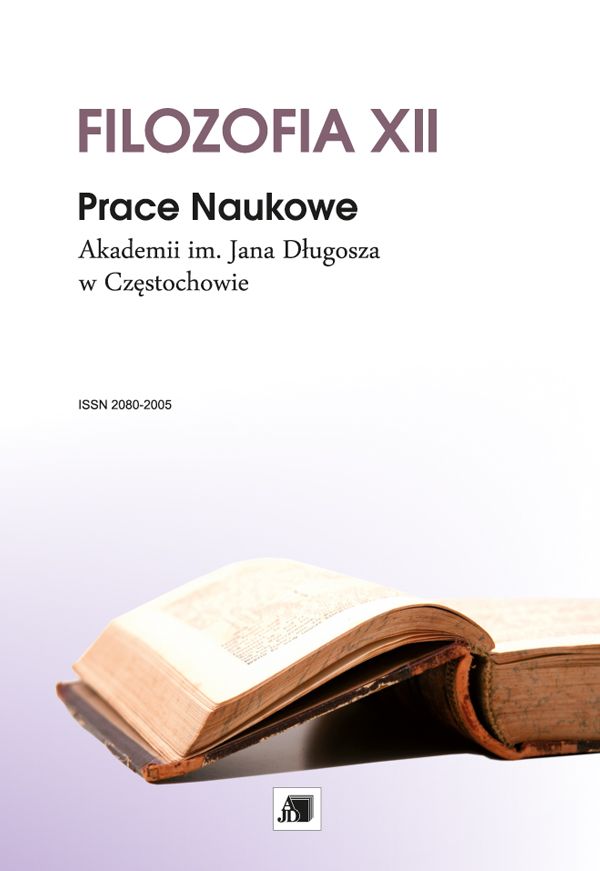Jak istnieje przedmiot, którego nie ma? (Wiersz Zbigniewa Herberta "Studium przedmiotu" w świetle fenomenologii Romana Ingardena)
How does the object, which there is not, exist? (Zbigniew Herbert’s poem "Study of the Object" in light of Roman Ingarden’s phenomenology)
Author(s): Halina Kozdęba-MurraySubject(s): Philosophy, Language and Literature Studies, Studies of Literature, Polish Literature
Published by: Uniwersytet Jana Długosza w Częstochowie
Keywords: poetry ; painting ; phenomenology ; realism ; idealism
Summary/Abstract: Z. Herbert’s poem "Study of the Object" poses a fundamentally philosophical question about the manner, in which an object exists as depicted in a painting. Can the theme of a work of art be nonobjective and express merely the experiences and feelings of an artist, like it was the case in K. Malevich’s suprematism? Or, does the artist, while creating his work, refer to the objects existing in the real world? This is essentially a philosophical debate about the existence of the world, whereby E.Husserl’s transcendental idealism is juxtaposed with realism as proposed by R. Ingarden. Herbert was well acquainted with prof. Ingarden’s phenomenology as he attended his lectures and in the aforementioned poem he clearly opts for the ontological realism. The theme of a painting should not be merely a depiction of the artist’s feelings, but it should include the world of objects which exist in reality, in the world outside of the artist’s consciousness, who, however, in the intentional act, attempts to grasp the essence, or eidos of the depicted object. Therefore Herbert chooses a simple chair as an object which becomes the artist’s challenge. The objects of the real world, as the theme of art, become the proponents of the truth about man and the world, in which he lives. Thus art receives axiological dimension since it reveals something which profoundly distinguishes man from nature and which means his constant search for the values of: truth, goodness and beauty.Wiersz Z. Herberta "Studium przedmiotu" stawia fundamentalne pytanie natury filozoficznej o sposób istnienia przedmiotu przedstawionego na obrazie. Czy tematyka dzieła sztuki może być bezprzedmiotowa i wyrażać jedynie doznania i odczucia artysty, tak jak to miało miejsce w suprematyzmie K. Malewicza? Czy też artysta, tworząc, odwołuje się do przedmiotów istniejących w świecie realnym? Jest to tak naprawdę filozoficzny spór o istnienie świata, w którym transcendentalny idealizm Husserla zostaje przeciwstawiony realizmowi R. Ingardena. Herbert znał dobrze fenomenologię prof. R. Ingardena, gdyż uczęszczał na jego wykłady, a w omawianym wierszu wyraźnie opowiada się po stronie realizmu ontologicznego. Tematem obrazu nie powinno być czyste doznanie artysty, ale świat przedmiotów istniejących realnie, w świecie zewnętrznym wobec świadomości twórcy, który jednak w akcie intencyjnym próbuje uchwycić istotę, czy też eidos ukazanego przedmiotu. Dlatego też wybór Herberta pada na zwykłe krzesło jako przedmiot będący wyzwaniem dla malarza. Przedmioty świata realnego, jako temat sztuki, stają się rzecznikami prawdy o człowieku i otaczającym go świecie. Sztuka ma wówczas wymiar aksjologiczny, ponieważ ukazuje coś, co diametralnie wyróżnia człowieka w świecie przyrody, a co jest jego ciągłym poszukiwaniem wartości: prawdy, dobra i piękna
Journal: Prace Naukowe Akademii im. Jana Długosza w Częstochowie. Filozofia
- Issue Year: XII/2015
- Issue No: 12
- Page Range: 201-217
- Page Count: 17
- Language: Polish

